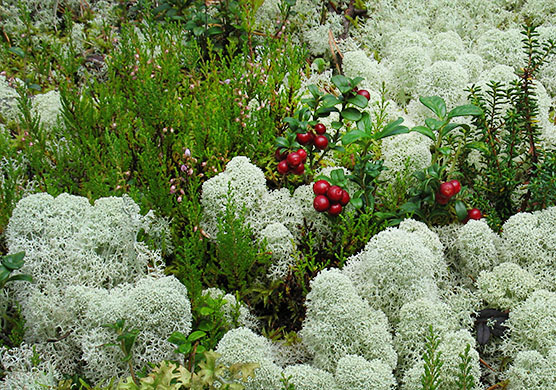Press release 2013-12-16 at 14:18
Report by Finnish Environment Institute and Finnish Forest Research Institute (Metla)

Species found in nutrient-poor habitats, such as heather, lingonberry, crowberry and lichens in particular are sensitive to nitrogen deposition. Photo Hannu Nousiainen, Metla.
Unless nitrogen emissions are curbed, the diversity of plant communities in Europe's forests will decrease. Atmospheric nitrogen deposition has already changed the number and richness of forest floor vegetation species in European forests over the last 20–30 years. In particular, the coverage of plant species adapted to nutrient-poor conditions has reduced. However, levels of nitrogen deposition in Finnish forests remain small compared to Southern and Central Europe.
These results will be presented as part of international research published in the journal Global Change Biology. Researchers from the Finnish Environment Institute and the Finnish Forest Research Institute (Metla) participated in this research, which concludes that unless nitrogen emissions are curbed, the diversity of plant communities in Europe's forests will decrease. The work involved the examination of long-term changes in vascular plant communities within a 1 300 monitoring grid covering 28 forested areas in various parts of Europe.
The number and richness of forest floor vegetation species in European forests have changed over the last 20 to 30 years, due to wet and dry deposition of atmospheric nitrogen. In particular, low-nutrient or acidic habitats are sensitive to long-term nitrogen deposition. Among such habitats, coverage of species such as heather and may lily has been reduced in many areas, in which nitrogen deposition has exceeded a certain threshold value i.e. the critical nitrogen load.
The largest changes in vegetation have occurred in Southern and Central European forests. Although deposition has not yet markedly affected species numbers within plant communities, most new species spreading into forests during the monitoring period have been types that favour nitrogen.
Finland still has a small nitrogen load
Four monitoring areas located in Finnish nature reserves were covered by the research. These areas were subject to markedly lower nitrogen deposition (0.6–1.9 kg of nitrogen per hectare per year) compared to areas subject to greater nitrogen deposition in Central Europe (10–20 kg N/ha/year) or Italy (20–30 kg N/ha/year).
Critical nitrogen loads applied in the research are based on the previously published results of long-term field research and experiments. By critical nitrogen loads, we refer to nitrogen deposition known to have harmful effects on the functions of more sensitive organisms in the ecosystem. The critical nitrogen load in boreal forests is estimated to be fairly small (5–8 kg N/ha/y), since northern forest ecosystems are highly sensitive to the effects of excess nitrogen. Such areas in Finland include nutrient-poor and dry pine forests in particular.
Although nitrogen deposition remains small in Northern Europe, even a slight rise in long-term deposition could change the competitive relationship of vascular plants by promoting the dissemination and growth of nitrogen-favouring species.
The effects of nitrogen deposition on Finland's forest vegetation can only be investigated with the assistance of a permanent environmental monitoring network. According to long-term monitoring by the Finnish Forest Research Institute (Metla), tree felling is still the key factor in changes to forest floor vegetation.
This monitoring reveals a reduction in lichens throughout Finland, including in unfelled forests. In Northern Finland, reindeer grazing is the key factor in lichen reduction. Slow-growing lichens in Southern Finland can also suffer due to the rapid growth of and shading by plants benefiting from nitrogen deposition.
-
Forest floor vegetation response to nitrogen deposition in Europe. Thomas Dirnböck, Ulf Grandin, Markus Bernhardt-Römermann, Burkhardt Beudert, Roberto Canullo, Martin Forsius, Maria-Theresia Grabner, Maria Holmberg, Sirpa Kleemola, Lars Lundin, Michael Mirtl, Markus Neumann, Enrico Pompei, Maija Salemaa, Franz Starlinger, Tomasz Staszewski and Aldona Katarzyna Uziębło. Global Change Biology (2013), doi: 10.1111/gcb.12440
Further information
Professor Martin Forsius, Head of Unit, Finnish Environment Institute
Tel. +358 (0)295 251 118, firstname.lastname@ymparisto.fi
Senior Researcher Maria Holmberg, Finnish Environment Institute
Tel. +358 (0)295 251 181, firstname.lastname@ymparisto.fi
Researcher Maija Salemaa, Finnish Forest Research Institute (Metla),
Tel. +358 (0)29 532 5479, firstname.lastname@metla.fi
Links